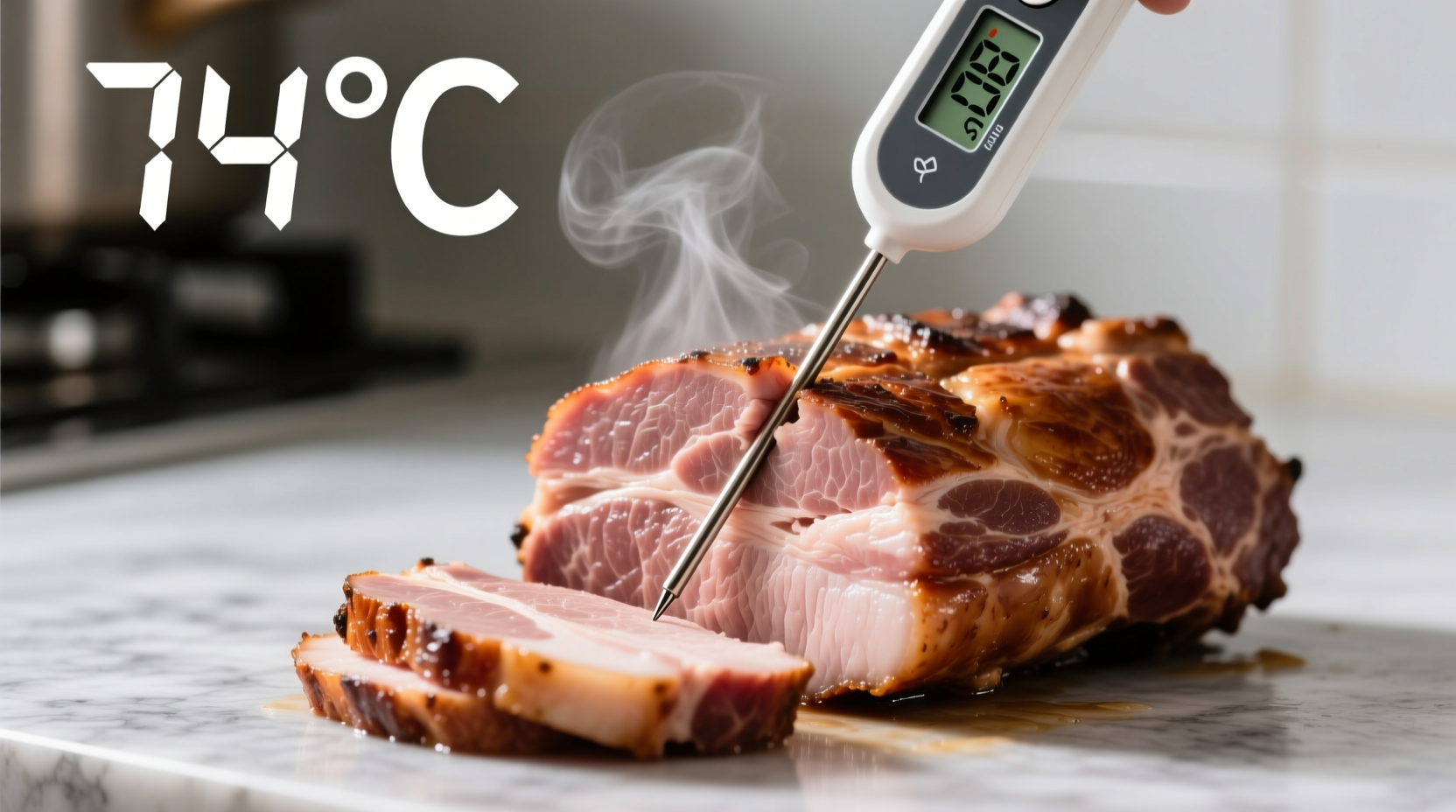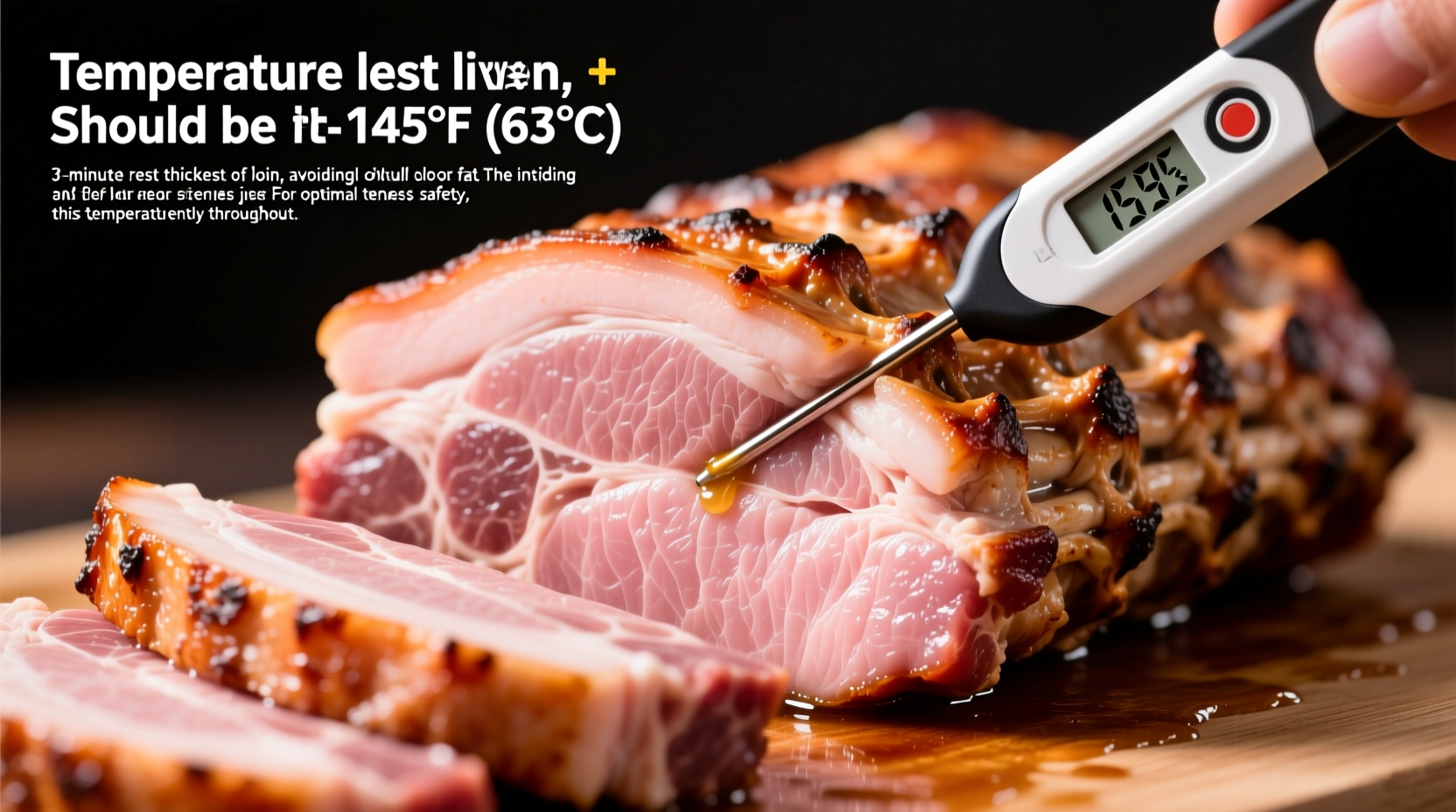The perfect internal temperature for cooked pork loin is 145°F (63°C) with a 3-minute rest time, according to USDA Food Safety and Inspection Service guidelines. This temperature ensures food safety while maintaining optimal juiciness and tenderness.
Ever wondered why your pork loin turns out dry or tough despite following a recipe? The secret lies in precise temperature control. Cooking pork loin to the correct internal temperature isn't just about food safety—it's the key to achieving restaurant-quality results in your home kitchen. In this guide, you'll discover exactly when to pull that pork loin from the heat for perfect results every time, plus professional techniques to avoid common cooking mistakes.
Why Temperature Matters More Than Timing
Unlike chicken or ground meats, pork loin requires precision rather than arbitrary cooking times. The ideal 145°F target strikes the perfect balance between safety and quality. At this temperature, harmful bacteria like Salmonella and Trichinella are eliminated while preserving the meat's natural moisture. The National Pork Board confirms this standard through extensive food safety testing, replacing outdated recommendations that called for much higher temperatures.
| Temperature Range | Doneness Level | Texture & Appearance | Safety Status |
|---|---|---|---|
| 130-135°F (54-57°C) | Rare | Pink center, very juicy | Not recommended |
| 140-145°F (60-63°C) | Medium-rare | Light pink center, tender | USDA safe with rest time |
| 150-155°F (66-68°C) | Medium | Slightly pink, firm texture | Safe but less juicy |
| 160°F+ (71°C+) | Well-done | No pink, dry texture | Safe but overcooked |
The Evolution of Pork Cooking Standards
Understanding why 145°F became the standard requires looking at historical changes in pork production. In 2011, the USDA revised its recommendation from 160°F to 145°F based on improved farming practices and reduced parasite risks. This timeline shows the progression:
- Pre-1990s: 165-170°F recommended due to trichinosis concerns
- 1990s-2011: 160°F standard as parasite risks decreased
- 2011-Present: 145°F with 3-minute rest as modern farming virtually eliminated trichinella risks
These changes reflect advancements documented by the Centers for Disease Control and Prevention (CDC), which shows trichinellosis cases have dropped from approximately 400 annually in the 1940s to fewer than 20 cases per decade today (CDC.gov/parasites/trichinellosis).
Measuring Temperature Like a Pro
Accurate temperature measurement requires proper technique:
- Use an instant-read digital thermometer for precision
- Insert probe into thickest part of the meat, avoiding bone or fat
- Check multiple spots as heat distribution varies
- Verify temperature 5-10 minutes before expected finish time
Many home cooks make the critical error of checking temperature too late. Pull your pork loin from heat when it reaches 140°F—the residual heat will carry it to 145°F during resting. This technique, called carryover cooking, prevents overcooking.

Resting: The Secret Step Everyone Skips
That mandatory 3-minute rest isn't just bureaucracy—it's science. During resting:
- Internal temperature continues rising 5-10°F (carryover cooking)
- Proteins relax, redistributing juices throughout the meat
- Surface moisture reabsorbs, creating better texture
Cover loosely with foil to retain heat without steaming the surface. Cutting too soon releases precious juices onto your cutting board rather than staying in the meat.
Avoiding Common Temperature Mistakes
Even experienced cooks fall into these temperature traps:
- The Visual Test Trap: Relying on color alone (pink doesn't mean unsafe)
- Thermometer Placement Errors: Measuring near bone or fat gives false readings
- Insufficient Resting: Cutting immediately after cooking loses up to 40% more moisture
- Overcorrecting: Pulling meat too early then overcooking during rest period
For best results, invest in a reliable thermometer like the ThermoPro TP03—recommended by the American Institute of Culinary Professionals for its accuracy within ±0.5°F.
Cooking Method Considerations
While the target temperature remains constant, cooking methods affect your approach:
- Roasting: Pull at 140°F for even heat distribution in oven
- Grilling: Pull at 138°F due to higher surface heat exposure
- Sous Vide: Maintain 140-145°F for 1-4 hours for perfect edge-to-edge doneness
- Smoking: Target 142°F to account for temperature fluctuations in smoker
Remember that thicker cuts require more rest time—add 1 minute per inch of thickness beyond the standard 3 minutes.
Troubleshooting Temperature Issues
When things go wrong, here's how to recover:
- Undercooked (below 140°F): Return to heat source until 140°F, then rest
- Overcooked (155°F+): Slice thinly against grain and serve with pan sauce
- Inconsistent readings: Check multiple spots and average the results
- Temperature stall: Normal during slow cooking; continue monitoring
For dry results, try repurposing overcooked pork in tacos or sandwiches where added moisture from toppings compensates for lost juices.
Perfect Pork Loin: Your Action Plan
Follow this step-by-step protocol for foolproof results:
- Bring pork loin to room temperature (30-60 minutes)
- Season and sear surface for flavor development
- Roast/grill until internal temperature reaches 140°F
- Remove from heat source immediately
- Rest 3-10 minutes (depending on thickness)
- Verify final temperature has reached 145°F
- Slice against the grain at 1/4-inch thickness
This method consistently delivers juicy, flavorful pork loin that surpasses restaurant quality. The USDA Food Safety and Inspection Service confirms this approach meets all safety requirements while maximizing eating quality (FSIS.usda.gov/cooking-meat-done).
Frequently Asked Questions
- Can pork loin be pink at 145°F and still be safe?
Yes, pork loin can safely have a slight pink hue at 145°F. Modern farming practices have virtually eliminated trichinella risks. The USDA confirms that pork cooked to 145°F with a 3-minute rest is safe regardless of color.
- What happens if I cook pork loin to 160°F?
Cooking pork loin to 160°F causes significant moisture loss as proteins tighten excessively. The meat becomes dry and tough, losing up to 20% more juices compared to cooking to 145°F. While still safe, the eating quality suffers substantially.
- How long should I rest pork loin after cooking?
Rest pork loin for 3 minutes minimum, but 5-10 minutes is better for thicker cuts. Resting allows juices to redistribute throughout the meat. Cover loosely with foil to maintain temperature without creating steam that would soften the crust.
- Why does my pork loin temperature rise after removing from heat?
This 'carryover cooking' occurs because the outer layers of meat remain hotter than the center, continuing to transfer heat inward. In pork loin, temperature typically rises 5-10°F during resting. This is why you should remove meat at 140°F to reach the target 145°F.











 浙公网安备
33010002000092号
浙公网安备
33010002000092号 浙B2-20120091-4
浙B2-20120091-4